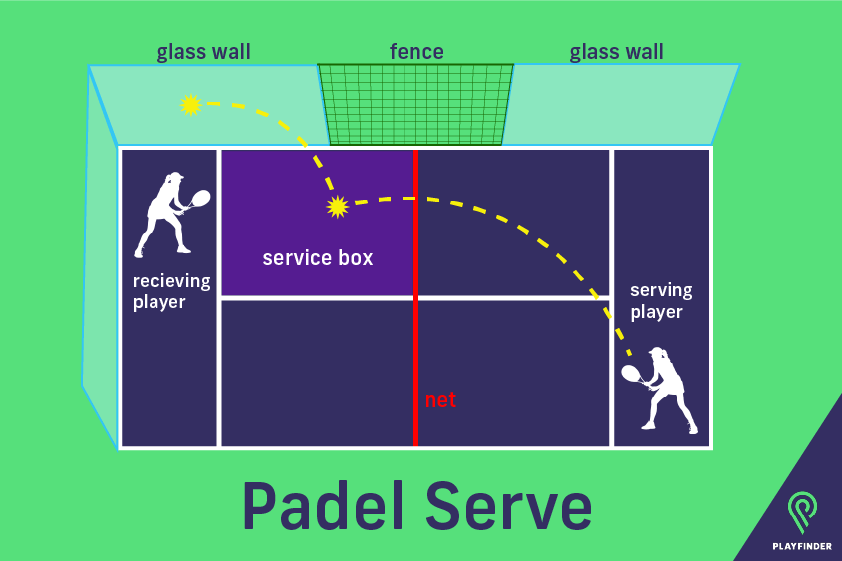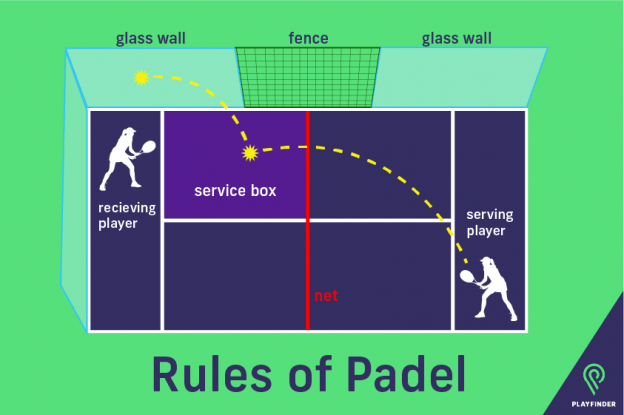Padel rules | Learn How to Play Padel
12 June 2023 • By - Playfinder
Padel Rules | How to Play Padel
Padel tennis, a popular racket sport, has gained immense popularity in recent years. Combining elements of tennis and squash, it offers a unique and exciting experience for players of all skill levels. To fully enjoy and excel in padel tennis, understanding the rules of the game is essential. In this article, we will provide you with a comprehensive guide to the rules of padel tennis, ensuring you’re well-equipped to play and compete with confidence.
Table of Contents:
- What is Padel Tennis?
- Padel rules
- Scoring System
- Padel Tennis Equipment
- Strategies and Tips for Success
1. What is Padel Tennis?
Padel tennis is a racket sport played on a specially designed court enclosed by glass walls and metal mesh fencing. It features teams of two players each, who aim to hit the ball into the opponent’s side of the court, similar to tennis. However, padel tennis incorporates unique elements, such as the use of walls to keep the ball in play, adding an exciting twist to the game.
2. Padel Rules
2.a The Serve
- The server must stand with both feet behind the baseline, within the service box.
- The ball must be hit below waist level, diagonally across the court, and land in the opposite service box.
- The serve should always hit the ground first before hitting the side or back glass wall.
- The ball is not allowed to hit the wire fence after bouncing off the service box.
- The server must keep at least one foot on the ground when hitting the serve.
- The server has two attempts to deliver a valid serve.

Padel serve – the ball has to bounce in the service box first before going to the player or bouncing off the side or back glass wall
2.b Ball in Play:
- After the serve, the ball must bounce once on the receiver’s side before it can be returned.
- Once the ball is in play, it can be hit off the walls or directly, similar to squash.
- The ball must be hit before it bounces twice on the ground.

Once the ball is in play, it can be hit off the walls or directly, similar to squash.
2.c Faults
- A fault occurs if the serve hits the net and fails to land within the opponent’s service box.
- Hitting the ball out of bounds results in a fault.
- Serving out of turn or from the wrong side of the court is also a fault.
2.d Let
- A let occurs if the serve hits the net and lands in the opponent’s service box.
- In such cases, the server gets another attempt to serve without penalty.
2.e Change of Sides
- Players change sides after every odd-numbered game in a set.
- During the changeover, teams switch ends of the court.
2.f Winning the Game
- In a match, there are three sets, and each set consists of six games. To win a set, a team or pairing needs to win six games with a margin of at least two games.
- However, if the score reaches 6-6, a tiebreak is played. In the tiebreak, the first side to reach seven points with a lead of at least two points is declared the winner.
3. Scoring System
Padel tennis follows a similar scoring system to tennis. The scoring system includes:
- Points: The game starts at “0-0” and progresses to “15-0,” “30-0,” “40-0,” and “game point.”
- Deuce: If both teams reach “40-40,” it becomes a deuce, and two consecutive points are required to win the game.
- Advantage: If a team wins a point after deuce, they gain the advantage. If they win the next point, they win the game. If the opposing team wins the point, it goes back to deuce.
- Sets: Matches are typically played in a best-of-three sets format.
4. Padel Tennis Equipment
To play padel tennis, you will need the following equipment:
- Padel racket: Smaller than a traditional tennis racket, it features perforated faces and no strings.
- Padel balls: Slightly smaller and less pressurised than regular tennis balls, specifically designed for padel tennis.
- Suitable footwear: Non-marking shoes with good traction to ensure stability on the court.

Padel court size – 20m x 10m
5. Strategies and Tips for Success in Padel
- Master the use of walls: Utilize the walls strategically to create angles and unexpected shots.
- Communication is key: Maintain clear communication with your partner to coordinate shots and cover the court effectively.
- Play to your strengths: Identify your strengths and adapt your gameplay accordingly. Whether it’s powerful shots or precise placement, focus on your team’s abilities.
- Practice consistency: Padel tennis rewards consistency. Work on your control and placement to maintain rallies and force errors from your opponents.
Padel tennis offers a thrilling and dynamic experience for players of all skill levels. By understanding the rules outlined in this comprehensive guide, you are now equipped to step onto the court with confidence. Whether you’re a beginner or an experienced player, padel tennis provides endless opportunities for enjoyment and improvement. So find a padel court near you, grab your padel racket, gather a partner, and dive into the exciting world of padel tennis!
Further reading
- Padel court dimensions and why it matters.
- Padel court cost – development and maintenance




